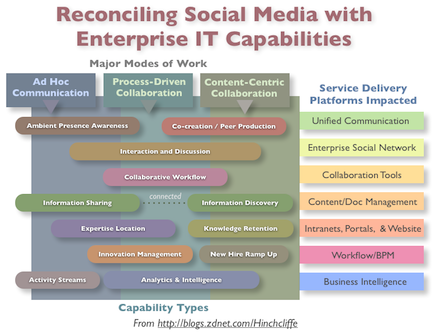Reconciling the enterprise IT portfolio with social media

At this point, organizations are realizing they have to put some serious thought into making organization-wide sense of social media service delivery. Enterprise social media used to be quite a bit simpler. Either it consisted of a few blogs and wikis being used in the far corners of the organization or it was a bit of external social media for marketing and customer support purposes. Now social media is making significantly deeper inroads in various ways across today's enterprise IT portfolios.
Social media is now a growing component of enterprise communication and collaboration, with the latest Frost and Sullivan data from this year showing that out of 200 C-level execs, sixty-nine percent were closely tracking "social media, placing it ahead of telepresence, VoIP, shared team spaces, soft phones, and even unified communications and unified messaging." Half of the respondents say social media is already used within their organization, and 41 percent are using the technology personally.
This is driving areas of the organization responsible for unified communication, document management, the intranet, and even workflow and business intelligence to address the influx of social media into their respective business functions as vendors add the capabilities and end users increasingly expect or even demand them.
In the companies I've talked with this year, this rapidly changing dynamic has complicated strategic IT planning while also making platform and tool selection the primary focus of attention instead of perhaps more important social media adoption issues. While the large enterprise social business vendors such as IBM, Cisco, Jive, and Microsoft all have increasingly mature offerings, sorting out how social media will have presence in the business has become significantly more complex due to rapidly increasing choice, proliferation of social media channels, and poor integration and standards. Companies are working hard this year to get their arms around the accumulating IT issues while at the same time grappling with how social media is transforming the way their organizations engage with their customers, business partners, and workers.
Contributing to the overall challenge is almost too much social media choice: Many top enterprise software vendors from Saba and Salesforce to SAP and Oracle are incorporating social media ever deeper into the way their products work. Fortunately, the use of social media features in existing software packages are often optional at this point. It's clearly up to organizations, however, to determine the manner in which their internal and external service delivery incorporating social media is going to function in a way that's easy to understand by internal business stakeholders.
The social media service delivery challenges
Along with this, business and IT leaders are struggling to figure out specifically where social media functions belong, both in terms of 1) delivery platform as well as 2) organizational capability.
For the former, businesses are asking a lot of hard questions these days. Is enterprise social media an intranet function? Or is it part of an social network that runs side-by-side with e-mail and the internal portal? Perhaps it's most at home as part of content and document management? Or maybe it's a single consistent capability that faces both externally and internally as we're seeing with Jive and a few other platforms. The answers to these questions largely seem to be yes, but without an obvious road to connect all of them together into something cohesive.
Part of the issue, as Information Week's Michael Finneran recently pointed out, is that "most companies haven't made nearly enough headway on basic integration. A collaboration architect for a major global manufacturer says a lack of standards is still a major roadblock." That existing business applications and IT tools are also sprouting social media features is turning into as big a headache as the poor integration between platforms.
For the latter, organizations are today are working to determine the best internal home for social media management and oversight. While some are looking at corporate communications and HR, it is IT and the line of business that are often in charge of social media projects in the short-term. Longer term, I've written about a move to develop social business units that we're seeing in organizations higher on the maturity curve, as well as the more common "triumvirate approach" when organizing for social business that usually involves a committee of key stakeholders in HR, brand, corporate communications, and IT.
Related: Ten emerging Enterprise 2.0 technologies to watch.
At this point, organizations are realizing they have to put some serious thought into making organization-wide sense of social media service delivery. Like business were forced to do five to ten years ago with traditional IT, the days of putting off social media strategy and portfolio rationalization has now passed. While I've painted a complex picture of the issues and concerns here, the good news is that some businesses are now finding their way and I've attempt to synthesize the issues and some potential solutions into a list below.
What then are the top issues organizations are grappling with today in terms of reconciling social media with their existing IT portfolios? These seem to be the most common ones:
Reconciling social media and enterprise IT: The issues
- Defining enterprise social identity. Who owns social identity has also been a problem on the Web itself, but enterprises have long had effective identity strategies, typically centered around LDAP and Active Directory for Single-Sign On (SSO). However, as traditional user profiles become rich user profiles that consist of more information including a dynamic and growing set of connected friends and colleagues, it's not as clear where social identity in the enterprise should reside. A rich user profile, and one that contains a user's full social graph (see full set of issues here), is the ultimate goal here. This has as much to do with a good user experience as it does with an easy to integrate master system of record for social identity. While there is some hope around enterprise standards in this space (read an excellent overview of the new User Management Access (UMA) proposal by Alex Williams), it may be approaches such as recent thinking on SAML and social identity that can enable much of the interoperability within and between enterprises and the Web. For now, the most common situation is that enterprise social software uses existing SSO resources for authentication and keeps the user's social graph internal to the platform. Ultimately, the issue with this approach is that it prevents users from easily tapping into their social graph -- one of the fundamental aspect of social networks -- from other enterprise applications. One easy work around for now is for enterprise software to publish into the activity stream that's inside the 'official' social network, providing simple but effective integration between the two. Barring that, letting users share links to enterprise information they wish to publicize, work with, or share works too, providing they are Web-oriented.
- Establishing a core set of social media capabilities. I've said before that, as much as they might like to, it's unlikely that most large enterprises will be able to adopt a single social media/Enterprise 2.0 platform for all uses. For one, there are just too many different ways that social media must be used in an organization for a single platform to meet all the requirements. Second, we are moving towards a world where there will be many more smaller, special purpose apps rather than large, monolithic do-everything platforms. Fortunately, there seems to be a natural breakdown, where there is a single enterprise social network, but multiple community platforms, social CMS/DMS, and other tools. Where it can stop working well is when other enterprise IT platforms replicated the user profile and activity stream. When this is duplicated, the resulting fragmentation can quickly create communication and collaboration silos. Consequently, when I see a large enterprise doing internal social media well, they typically are delivering a primary internal social network while allowing other social tools to be used across the organization as long they don't fully turn on the rich user profile features. Achieving effective balance between social media platforms in this scenario is still an art more than a science. But as enterprise activity streams standardize, open up, and move out of individual software products they will be become centered instead within the user experience of choice (ala Tweetdeck) and this will (hopefully) be less and less of an issue. There are also other ways that I've explored in more detail to reconcile core internal media with the enterprise.
- An effective discovery/enterprise search strategy. Often neglected by enterprises in their social media efforts, good search is what makes a social intranet useful, period. If you can't find the person or information that exists, the information in internal social media is largely valueless (getting at least one use hopefully, instead of the hundreds of reuses over the years.) The problem typically is that individual social tools usually provide search engines only for themselves and not in the full context of the enterprise intranet. A number of the most successful projects I've seen has ensured that search is not a second class citizen. It's the ability to more quickly discover content, ongoing processes, and people in digital conversations that's one of the biggest sources of ROI for enterprise social media. A good place to start: Engage the search team early and arrange a parallel effort to deliver effective discovery of the knowledge and stored collaboration accumulating in internal social media.
- Reconciling horizontal and vertical social media. As social media and social networking features are added to a growing list of enterprise software, this is about figuring out out how they can best co-exist. As mentioned in point #2 above, there will be many more vertical, niche social media apps than broad, horizontal apps used by the whole organization. Then there are specialty platforms, such as social analytics, which operate next to and instrument the organizations so that it can be managed, monitored, as well as measured and turned into business intelligence. Creating an easy to understand strategy to define where social media platforms are being/will be used and how they connect is the object here. Often, just creating a map that identifies where social media fits into the existing IT portfolio along with clear parameters that define or assess the health, risk, value, alignment, balance, and constraints within an IT governance framework that's updated for social business can greatly help. I don't see heavyweight approaches to this working very well, but simple, clear ground rules that all the fiefdoms and constituencies in the organization can understand (and follow or ignore to their benefit or peril) is just a natural part of a proactive and constructive CoIT strategy for social media.
Of course, organizations will have other specific issues unique to themselves as they attempt to modernize and update their IT portfolio strategy for social media, but the list above is a good start on the top-level concerns. Although they are somewhat focused on internal social media, the issues are largely the same for external social media but some additions.
I would also like to hear more from those that are tackling social media at a strategic level and share what the issues that you're coming across. Social business and closely related topics are one of the top areas this year to address on the agendas of many CHROs, CCOs, CIOs, and line of business executives. Sharing what we're learning as an industry about what works and what doesn't will greatly help organizations navigate one of the most significant changes to IT in a generation.
